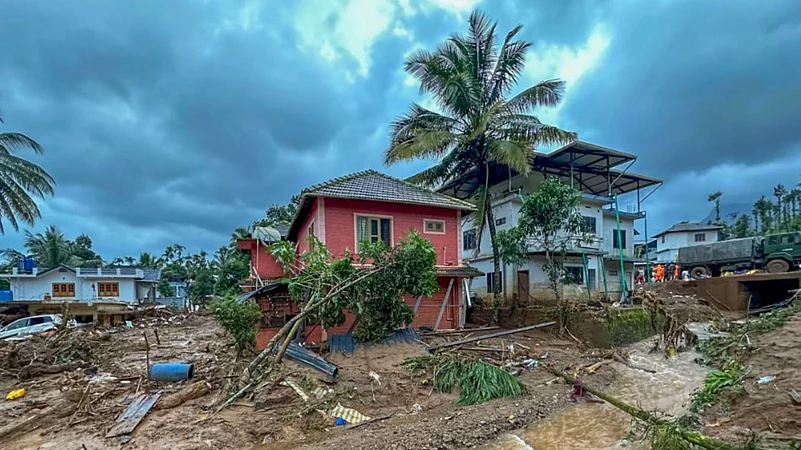Kerala’s Wayanad district’s landslide has increased the death toll to 148, with several injured and trapped until now. Most of the victims reportedly worked in tea estates and cardamom estates. As per media reports, the landslide happened when most of the people were sleeping in their homes at night, leading to an increase in the death toll.
Situated in the north-eastern part of Kerala, Wayanad is a small hill station that is famous amongst tourists for its waterfalls, bird-watching sites, trekking trails, and more. Now that the once beautiful hill station is surrounded by pain and misery, the question arises as to why the landslide happened. Experts have highlighted climate change as one of the reasons behind this horrific incident. This leads to a wider discussion—what is the economic cost of climate change? As per an RBI report, up to 4.5 percent of India's GDP could be at risk by 2030 due to lost labor hours caused by extreme heat and humidity.
Advertisement
Climate Change and Loss of Forests is the Reason, Say Studies
Scientists and experts urged the implementation of a landslide prediction system and the construction of safe structures for at-risk populations following a series of landslides in Kerala.
Speaking to PTI, Roxy Mathew Koll, a climate scientist at the Indian Institute of Tropical Meteorology, said, “Often, landslides and flash floods occur in regions where the impact of both climate change and direct human intervention in terms of land use changes is evident. At the same time, there have been many severe landslides in regions with minimal land use changes as well.”
Advertisement
A research paper titled ‘Climate change-induced landslide vulnerability: empirical evidence from Shimla district, Himachal Pradesh, India’ says that over the decades, changes in mountain landscapes have been significantly influenced by variable rainfall patterns, higher soil erosion rates, extreme temperatures, and shifts in land use.
In a similar vein, Kerala accounted for 10 of the 30 districts in India most prone to landslides, with Wayanad coming in at number 13 in a land atlas published in 2023 by the National Remote Sensing Centre, ISRO.
S. Abhilash, the director of the Advanced Centre for Atmospheric Radar Research at Cochin University of Science and Technology (CUSAT), explained to PTI that the warming of the Arabian Sea is enabling the development of deep cloud systems. This results in very heavy rainfall in Kerala over a short duration, raising the risk of landslides.
Economic Survey on Climate Change
Any disaster comes with an economic toll. The Union Budget that was presented recently, announced assistance to states that face frequent floods and landslides. The states include Assam, Himachal Pradesh, Uttarakhand and Bihar.
In her budget speech, Finance Minister Nirmala Sitharaman said that the government will provide assistance to some states for flood management and related projects.
Talks about climate change and its impact are gaining prominence. The Economic Survey that was released a day before the Budget highlighted that India is faced with balancing economic development with meaningful climate action, similar to other developing nations. Additionally, the proposed solutions to climate change, which often form the basis of criticism against India, overlook how sustainability is inherently integrated into the Indian way of life.
Advertisement
The survey further criticized developed countries for overconsumption and shifting the burden of climate change to developing countries. It says, “On the one hand, developing nations are forcefully nudged to sign up for climate commitments that they are not ready for. On the other hand, the developed world is in a mad ‘Scramble for Africa’ kind of rush to usher in the latest and most expansive AI (artificial intelligence) ecosystem.”
The Financial Impact of Climate Change
A common argument by several experts has been that developing countries are more vulnerable to climate change, and India is no exception to it.
Advertisement
According to the RBI's report "Report on Currency and Finance 2022-23: Towards a Greener, Cleaner India," up to 4.5 per cent of India's GDP could be at risk by 2030 due to lost labor hours caused by extreme heat and humidity.
Furthermore, an international climate report published on October 28, 2021, covering G20 countries, indicates that heatwaves could last 25 times longer and increase in severity between 2036 and 2065 if the current rate of carbon emissions is not reduced.
To add to it, a World Bank report says India's GDP could decrease by 2.8 per cent due to rising temperatures and altered monsoon patterns caused by climate change, potentially lowering the living standards for almost half of the country's population by 2050.
Advertisement
With climate change becoming a persistent problem of our lives, India has set up several climate goals, such as achieving net zero emissions by 2070, producing five million metric tons of green hydrogen annually by 2030, and more. However, the broader aspect of climate change is something that needs to be dealt with between developed and developing countries.
















 Just one email a week
Just one email a week